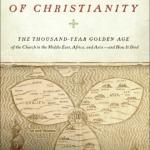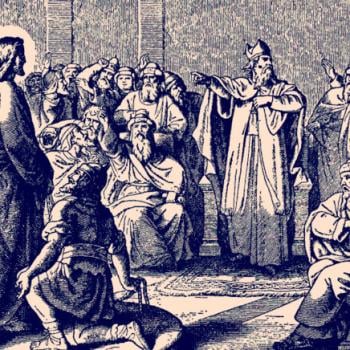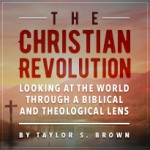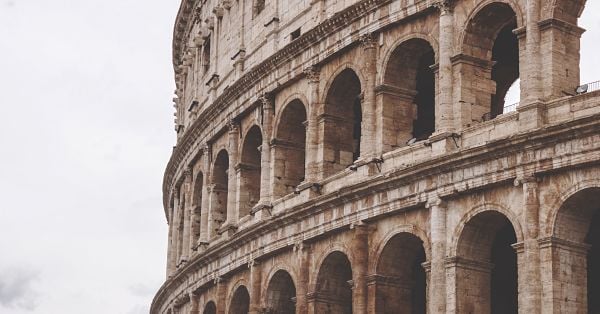Another day, another book review over at the New York Times extolling a tome that seeks to show how the “barbarous” and “thuggish” early Christians destroyed the “enlightened” and “cosmopolitan” order of the ancient pagan world. The book in question is the The Darkening Age: The Christian Destruction of the Classical World by Catherine Nixey (Houghton Mifflin Harcourt, 2018). The review summarizes the general argument of the book in short order, namely that, contrary to conventional wisdom, the entrance of Christianity onto the scene of the ancient world was not a movement away from the dark paganism of the antiquity. Rather, Christianity itself was the coming darkness that enveloped and overtook a world of Romans and Greeks who were inclusive, open-minded, free of religious dogma; essentially ancient versions of a wealthy Manhattanites reading the Times and wondering aloud to themselves why the world isn’t as enlightened as they are.
Obviously my feelings on such a thesis are evident by my tone. And let me state right here that this post is not a critical review of Nixey’s book. Other’s, both Christian and non-Christian, have already done that work at length. Instead, these are my critiques of the mindset that Nixey and her NYT reviewers embody; that of a modern legend that Christianity brought about a darkening of the Western world and led to a millennium of backwardness and darkness. Not only do I think such an argument ignores the complexity of the ancient world and ancient Christianity it within it, I think it is animated by an intentionally anti-religious bias that skews any sort of reliable analysis. Of course, that is not to say that bias should not play a part in research and writing. We all have biases that we bring to any sort of project. I am a Christian for instance and so have a bias towards religious faith and Christian faith in particular. Nixey, as far as I can tell by the NYT review and from a Guardian review of the British edition of the book last year, is non-religious of some variety (though I am happy to be corrected on this if I am wrong) and so seems to have a bias toward such a position.
The problem is not with biases. The problem is when biases mutate into ideology and polemic. And that is precisely what happens with Nixey’s argument, itself little more than a repackaging of Edward Gibbon’s polemical and anti-clerical writings from the 18th century, themselves long since discredited by many historians. Indeed, Bettany Hughes (the NYT reviewer) acknowledges the polemical drive of the book:
This is a searingly passionate book. Nixey is transparent about the particularity of her motivation. The daughter of an ex-nun and an ex-monk, she spent her childhood filled with respect for the wonders of postpagan Christian culture. But as a student of classics she found the scales — as it were — falling from her eyes. She wears her righteous fury on her sleeve. This is scholarship as polemic.
Of course, scholarship as polemic is often shoddy scholarship. Don’t misunderstand me here. Good scholarship can often serve polemical purposes. But scholarship that is unambiguously and primarily driven by polemic, is more often than not bad scholarship. Indeed, this appears to be the case with Nixey’s argumentation. Nixey (channeling Gibbon) bemoans the destruction of pagan temples and statues of the gods. What monsters would destroy such works of art?! But of course for Christians, as for all of the ancients, pagan statues were not simply statues. They were representative images of supernatural entities who were thought to have great power over the elements of the world. For ancient Christians, such statues were often channels for the demonic and oppressive spirits whom Christ had come to defeat. To moderns such as ourselves (deprived as we are of the complex spiritual vision of reality) such defacement is simply the destruction of art. To the ancient Christians, it was nothing less than the destruction of channels of evil, siphons of demonic presence that enslaved and oppressed humans made in the image of God. Such defacement and destruction of pagan temples was not then tantamount to vandalism. It was an act of mercy on an enslaved world.
And of course Nixey also dredges up that tired old tale of the death of Hypatia at the hands of Christian mobs in Alexandria. Attached to this is the modern secularist legend of the Christian destruction of the Great Library of Alexandria that is often tied to Hypatia’s death. As several historians have demonstrated, by the late fourth century there was no library in Alexandria to destroy. Instead, the bulk of the library seems to have been destroyed during Julius Caesar’s invasion of Egypt in the first century B.C. Here is David Bentley Hart on the matter:
The Great Library of Alexandria is one of the more fascinating mysteries of late antique civilization. It enters history already as something largely legendary. Even Strabo, who died around a.d. 23, knew of it only as a tale from the past. We know that it had been built as an adjunct to the Great Museum in the Brucheium (the royal quarter of Alexandria) in the first half of the third century b.c. Its size, however, is impossible to establish.
The estimate in ancient texts varies wildly, between 40,000 scrolls—for the ancient world, an astounding but still plausible number—and 700,000—which is almost certainly impossibly high. And, as of yet, archaeologists have failed to find the remains of any building sufficiently large to have sheltered a collection on either scale.
Whatever the case, as Rohter says, various ancient sources report that the library was destroyed, either in whole or in part, during Julius Caesar’s Alexandrian campaign against Pompey in 48 or 47 b.c. If any part of it remained in the Brucheium, it would probably have perished when the museum was destroyed in a.d. 272, during Aurelian’s wars of imperial reunification. It was certainly no longer in existence in 391. . .
. . . The truth of the matter is that the entire legend was the product of the imagination of Edward Gibbon, who bizarrely misread a single sentence from the Christian historian Orosius, and from it spun out a story that appears nowhere in the entire corpus of ancient historical sources.
And what of the death of Hypatia? Was it really so simple as her being killed by an anti-scientific Christian mob who hated the fact that a woman had such standing? Hardly. While it is true that Hypatia died at the hands of a group of Christian paralabani (and something that all Christians should lament and decry as antithetical to the commandments of Christ) it was not because she was a scientist (known for her use of the astrolabe), nor because she was a woman, as Nixey (and Gibbon before her) asserts. Indeed as Hart notes, Hypatia was actually on very good terms with the Christian intellectual community of Alexandria. Synesius of Cyrene, both a Christian Platonic thinker and bishop, was one of her close friends and scientific collaborators. Again, Hart on the matter:
She was, all the evidence suggests, a brilliant lecturer in Platonic thought, a trained scientist, and the author of a few mathematical commentaries. Despite the extravagant claims often made on her behalf, however, there is no reason to believe she made any particularly significant contributions to any of her fields of expertise.
She was not, for instance—as she has often been said to have been—the inventor of either the astrolabe or the hydrometer. It is true that the first extant mention of a hydrometer appears in a letter written to Hypatia by her devoted friend, Synesius of Cyrene, the Christian Platonist and bishop of Ptolemais; but that is because Synesius, in that letter, is explaining to her how the device is made, so that she can arrange to have one assembled for him.
At the time of her death, she was probably not even the beautiful young woman of lore; she was in all likelihood over sixty.
She was, however, brutally murdered—and then dismembered—by a gang of Christian parabalani (a fraternity originally founded to care for the city’s poor); that much is true. This was not, however, because she was a woman (female intellectuals were not at all uncommon in the Eastern Empire, among either pagans or Christians), or because she was a scientist and philosopher (the scientific and philosophical class of Alexandria comprised pagans, Jews, and Christians, and there was no popular Christian prejudice against science or philosophy).
And it was certainly not because she was perceived as an enemy of the Christian faith; she got on quite well with the educated Christians of Alexandria, numbered many among her friends and students, and was intellectually far closer to them than to the temple cultists of the lower city; and the frankest account of her murder was written by the Christian historian Socrates, who obviously admired her immensely. It seems likely that she died simply because she became inadvertently involved in a vicious political squabble between the city’s imperial prefect and the city’s patriarch, and some of the savages of the lower city decided to take matters into their own hands.
As Hart argues, the cause of Hypatia’s death was not Christian anti-intellectualism or misogyny (traits of modern fundamentalists that are anachronistically projected onto ancient Christians), but rather the kind of the political infighting that has occurred all too often in human history. And as much as Christians were involved in such infighting (especially those parabalani who resorted to violence and murder) such actions should be decried and called out as wrong. But let us dispense with false claims that Christian belief itself was the cause of Hypatia’s death.
I could go on about Nixey’s (and again, the ghost of Giboon whom she channels) claims, but it seems unnecessary. None of the claims are particularly new or outrageous. As already mentioned, Edward Gibbon made most of them nearly three centuries ago, and many (if not most) have long since been discredited. Indeed, one need only ask of Nixey’s larger overarching thesis this simple question: “While it is true that some Christians advocated for the total annihilation of all remnants of pagan culture, who were the people who actively preserved, transmitted, and reintroduced the great classics of the Greco-Roman world to late medieval West?” While it is tempting to say Muslim scholars were the soul preservers of such texts (and they did play a part to be sure, especially with Aristotle’s works), the same question must be asked of them. And the answer is that it was Greek and Syriac-speaking Christian scribes and monks in the Eastern half of the Empire (which did not fall to outside attackers until 1453 A.D.) who continued to transmit and preserve the works of Homer, Plato, Aristotle, Horus, etc. Indeed, it was the Christian monasteries of the West and East who, by and large, safeguarded the classical tomes that we have today.
Here is Philip Jenkins, in his review of the book for Christian Century, on the subject of Eastern Christians preserving and transmitting classical texts:
In the eastern Mediterranean, the mighty Hellenistic city of Antioch dominated prosperous Syria and served as a transcontinental center of learning and scholarship. Antioch’s cultural role was quite unaffected for two centuries after the coming of Christianity, until the city was successively devastated by the appalling earthquake of 526 and the invading Persians in 540. If by happenstance Antioch had retained its original glory for a few more years, many thousands of its citizens would have perished in the subsequent pandemic known as the Plague of Justinian.
The ruin of Antioch cast a long shadow across a once-flourishing region. Most of the other great cultural centers of the Middle East were crippled by the long Roman-Persian wars of the early seventh century, followed immediately by Islamic conquests. During this crisis era, the Syriac Church of the East and other churches preserved and transmitted the intellectual treasures of pagan antiquity, including philosophy, science, and medicine. Eastern Christian centers like Nisibis and Gundeshapur became the cultural treasure houses of the age. Christian monks and clergy then translated those works for their Islamic conquerors, who subsequently bequeathed them to Christian Europe, thereby making possible the intellectual triumphs of the Late Middle Ages and Renaissance.
But such repudiations are somewhat boring. Not because they are unimportant, but because they have been so well-trodden. Instead, I’ll conclude this post by focusing on what Nixey ignores entirely, namely the destruction of darkness and entrance of light brought on by Christianity’s revolutionary entrance into the world.
I have written about this at length elsewhere, so I’ll keep my comments here brief. For all the beauty that the classical world produced, it produced just as much, if not more, darkness, pain, and evil.
Would Nixey laud the classical presupposition that most humans (e.g., slaves, women, children, basically anyone who was not a male, Roman citizen) are inherently inferior to those who held power through force? For the notion of that all human beings, regardless of ethnicity, class, or sex, are equal in the eyes of God as His image bearers, and thus equal before all laws, is one that only came into existence with the rise of Christianity. St. Paul’s Letter to Philemon, reprimanding Philemon for any potential mistreatment of his slave Onesimus (which under Roman law, Philemon had every right to do) would have been shocking enough to Greco-Roman sensibilities. But for Paul to say that he is sending Onesimus back to Philemon not as a slave but as a “beloved brother” and that Philemon is to welcome Onesimus as he would welcome Paul (Philem 1:16-17), well that was simply unheard of in the “enlightened” pagan world.
Would Nixey cheer on the paganism that said that the gods capriciously controlled the elements of the world and that humans were little more than slaves subject to their whims? For it was the Christian understanding of the world as the creation of the one transcendent Creator God, and thus rationally intelligible to human inquiry, that laid the foundation for the principles of modern scientific investigation.
Would Nixey look longingly at pagan cults like that of Cybele, whose priests would castrated themselves, picked up the bloody member, ran naked and bleeding through the streets, and then threw the dismembered genitals into a random Roman home, thus requiring said household to clothe and supply them indefinitely? And lets not forget the slaughtering of a bull whose blood was then poured upon a celebrant in a pit below the animal. Then of course there are the other sources of blood that ran through the streets of Rome and its territories: gladiatorial games, animal sacrifices, and the execution of slaves and dissidents by such horrific methods as crucifixion.
And last but not least, what would Nixey think of the pervasive and celebrated practice of child pederasty among Greek and Roman men? In the pagan world the sexual use of young children, particularly young boys, was not only permitted, it was often actively celebrated. Greco-Roman poets such as Juvenal, Horace, and Strato used terms like paiderastēs (“a lover of boys/children”) to describe what they perceived as the good of sexual activity with children. Of course the very thought of this is horrifying to us, but that is only because the early Christians looked at this commonly accepted, and even celebrated, practice and coined a new term to describe those who did it: paidophthoros (“a destroyer/corrupter of children”). What the pagan elite (those enlightened luminaries of whom Nixey speaks] viewed as good, the early Christians saw as utter evil. As A Larry Hurtado observes in his book Destroyer of the gods: Early Christian Distinctiveness in the Roman World (Baylor University Press, 2016), in the early Christian document called the Didache (ca. 100 AD) the explicit prohibition, “you shall not corrupt [sexually] children” (Did. 2.2) appears alongside prohibitions against murder and adultery. Such disgust with the pagan practice of sexual use of children appears in the work of Christian writers up through the second and third centuries AD, including Justin Martyr, Clement of Alexandria, and Origen, among others (pp. 167-68).
Indeed, Philip Jenkins thoroughly critiques the whole premise of an idealized pagan world that Nixey presents, as well as her attempt to resuscitate the academically-dead idea of the Middle Ages as the “Dark Ages”:
More troubling is the rosy account she offers of the pagan world that Christians struggled against. She depicts classical paganism as a gloriously rich culture marked by almost limitless tolerance of other faiths, except where those were evidently criminal or seditious. She minimizes the experience of Christian martyrdom to trivial proportions. She stresses the astonishing scientific achievements of that ancient pagan world, drawing a stark contrast with Christian obscurantism. Paganism, Nixey implies, is simply a better way of living than monotheism.
But she is not comparing like with like. Her portrait of classical pagan culture draws heavily on the Golden and Silver Ages, from roughly the second century BC to the second century AD. But that older world of Ovid and Horace was in ruins by the time of Constantine—and Christianity had nothing to do with the collapse. For reasons that were variously social, political, and economic, classical culture and literature were already in terminal decline, and scientific innovation had slowed dramatically. The pagan religious thought of Late Antiquity was widely marked by pessimistic and world-denying attitudes that condemned the material creation. This was the intellectual paganism that Christians confronted.
When historians today use the term Dark Ages, we generally restrict it to specific and narrow eras that affected some limited regions, where civil society collapsed for decades or even centuries. Nixey, though, regards the Christian curse as poisoning Western history far beyond the immediate post-Roman centuries. She characterizes the Dark Ages of scientific repression as extending through “a thousand years of theocratic oppression,” up to the Renaissance or even the Enlightenment. No serious academic historian is likely to support this view.
I could go on about the oppression and darkness that permeated so much of the pre-Christian pagan world, but I think I have made my point. To try and paint the classical world as almost wholly beautiful, enlightened, and free of religious dogmatism is not only unfair to the ancient Christians, it is intentionally dismissive of the complex historical nature of the ancient world. It is tempting to retroactively project one’s own feelings about post-Enlightenment Western rationalism onto the ancient Greeks and Romans. But the modern world as we know it, with all it’s emphases on equality, human rights, protection of the innocent and the weak, etc., is the result not of a pagan world, but of one transformed by the revolution of Christianity. One need not be a Christian to acknowledge this. Indeed, one need not elide the many moral failures of Christians over the centuries. I am a Christian myself and I certainly do not ignore such failures as the Crusades (though they too are often grossly misunderstood), medieval anti-Semitism, corrupt clergy, and fundamentalist anti-intellectualism. I decry them all quite firmly.
And yet it is precisely a Christian moral framework that allows me to decry such wrongs, not a pagan or secular one. Christianity did, in some sense destroy the classical world, but only in part. But it was this part that needed to be destroyed. The part that crushed the weak, the marginalized, and the oppressed into oblivion, all at the behest of the pagan gods and their proxy human rulers. And that is the most ironic part about polemical screeds like Nixey’s and Gibbon’s before her. The moral protest they raise is not a pagan or rationalist one at all. It is the protest of a world on the far side of the Christian gospel. It is something akin to a fussy child trying to hit her parent, screaming that the parent does nothing but hinder her. And yet all the while the parent is propping up the child on their knee, holding her so she does not fall to the ground. Tragicomic indeed.
















